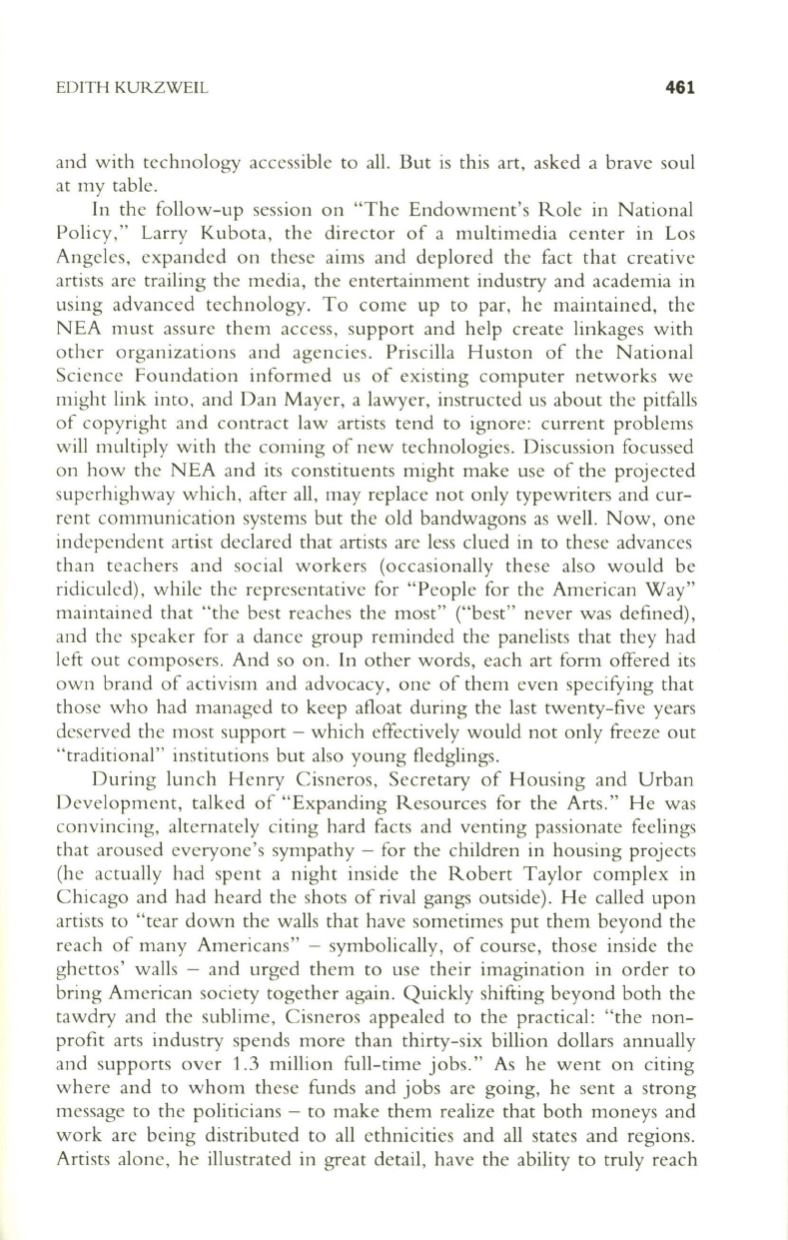
EDITH KURZWEIL
461
and with technology accessible to all. But is this art, asked a brave soul
at my table.
In the folJow-up session on "The Endowment's Role in National
Policy," Larry Kubota, the director of a multimedia center in Los
Angeles, expanded on these aims and deplored the fact that creative
artists are trailing the media, the entertainment industry and academia in
using advanced technology. To come up to par, he maintained, the
NEA must assure them access, support and help create linkages with
other organizations and agencies. PrisciIJa Huston of the National
Science Foundation informed us of existing computer networks we
might link into, and Dan Mayer, a lawyer, instructed us about the pitfalls
of copyright and contract law artists tend to ignore: current problems
will multiply with the coming of new technologies. Discussion focussed
on how the NEA and its constituents might make use of the projected
superhighway which, after all, may replace not only typewriters and cur–
rent communication systems but the old bandwagons as well. Now, one
independent artist declared that artists are less clued in to these advances
than teachers and social workers (occasionally these also would be
ridiculed), while the representative for "People for the American Way"
maintained that "the best reaches the most" ("best" never was defined),
and the speaker for a dance group reminded the panelists that they had
left out composers. And so on. In other words, each art form offered its
own brand of activism and advocacy, one of them even specifYing that
those who had managed to keep afloat during the last twenty-five years
deserved the most support - which effectively would not only freeze out
"traditional" institutions but also young fledglings .
During lunch Henry Cisneros, Secretary of Housing and Urban
Development, talked of "Expanding Resources for the Arts." He was
convincing, alternately citing hard facts and venting passionate feelings
that aroused everyone's sympathy - for the children in housing projects
(he actually had spent a night inside the Robert Taylor complex in
Chicago and had heard the shots of rival gangs outside). He called upon
artists
to
"tear down the walls that have sometimes put them beyond the
reach of many Americans" - symbolically, of course, those inside the
ghettos' waIJs - and urged them to use their imagination in order to
bring American society together again. Quickly shifting beyond both the
tawdry and the sublime, Cisneros appealed to the practical: "the non–
profit arts industry spends more than thirty-six biIJion dolJars annually
and supports over 1.3 million full-time jobs." As he went on citing
where and to whom these funds and jobs are going, he sent a strong
message to the politicians - to make them realize that both moneys and
work are being distributed to all ethnicities and all states and regions.
Artists alone, he illustrated in great detail, have the ability to truly reach


